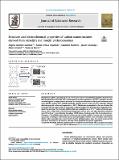Por favor, use este identificador para citar o enlazar a este item:
http://hdl.handle.net/10261/198289COMPARTIR / EXPORTAR:
 SHARE SHARE
 CORE
BASE CORE
BASE
|
|
| Visualizar otros formatos: MARC | Dublin Core | RDF | ORE | MODS | METS | DIDL | DATACITE | |

| Título: | Structure and electrochemical properties of carbon nanostructures derived from nickel(II) and iron(II) phthalocyanines |
Autor: | Sánchez-Sánchez, A.; Izquierdo Pantoja, María Teresa CSIC ORCID ; Mathieu, Sandrine; Ghanbaja, Jaafar; Celzard, Alain; Fierro, Vanessa | Palabras clave: | Metal phthalocyanines Hydrothermal carbonisation Catalytic graphitization Supercapacitors |
Fecha de publicación: | 14-nov-2019 | Editor: | Elsevier BV | Citación: | Journal of Advanced Research 22: 85-97 (2020) | Resumen: | Mesoporous carbons containing up to 3.6 at.% N and 4.4 at.% O and exhibiting graphitic character have been prepared from Ni(II) and Fe(II) phthalocyanines by direct pyrolysis or by HTC + pyrolysis, and subsequently applied as supercapacitor materials. No mesoporous templates or doping post-treatments were used, and the catalytic effect of Ni(II) and Fe(II), naturally present in the precursor molecules, allowed obtaining graphitic carbons at temperatures ≤ 900 °C. Metals were encapsulated in the core of onion–like structures with no contact with the electrolyte, so that electrodes were prevented from degradation during device operation. The materials exhibited high rate capabilities up to 1 V s−1, higher interfacial capacitances than a wide variety of materials possessing higher surface areas, and high capacitance retentions up to 99% at 5 A g−1 current density throughout 10 000 charge–discharge cycles. The electrochemical performances of the phthalocyanine-derived carbons are due to their graphitic character and to the pseudocapacitance contribution of the surface groups through Faradaic reactions. This work opens a new way to obtain carbon materials from a great family of metal phthalocyanines, since the central metal and the radicals of the latter can be varied to tune the carbon properties for specific applications. | Descripción: | 7 Figuras, 2 Tablas | Versión del editor: | http://dx.doi.org/10.1016/j.jare.2019.11.004 | URI: | http://hdl.handle.net/10261/198289 | DOI: | 10.1016/j.jare.2019.11.004 | ISSN: | 2090-1232 |
| Aparece en las colecciones: | (ICB) Artículos |
Ficheros en este ítem:
| Fichero | Descripción | Tamaño | Formato | |
|---|---|---|---|---|
| Journal Advanced Research_v22_2020_85-97.pdf | Artículo principal | 2,06 MB | Adobe PDF |  Visualizar/Abrir |
| J Adv Res 22_85-97 (2020) info sup.pdf | Información suplementaria | 6,66 MB | Adobe PDF |  Visualizar/Abrir |
CORE Recommender
PubMed Central
Citations
5
checked on 17-abr-2024
SCOPUSTM
Citations
16
checked on 19-abr-2024
WEB OF SCIENCETM
Citations
11
checked on 25-feb-2024
Page view(s)
213
checked on 19-abr-2024
Download(s)
234
checked on 19-abr-2024

